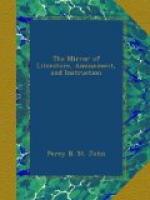The impression made on Sir Walter Scott by the ruins may be inferred from the following lines:—
“If thou would’st view fair
Melrose aright,
Go visit it by the pale moonlight;
For the gay beams of lightsome day
Gild but to flout the ruins grey.
When the broken arches are black in night,
And each shafted oriel glimmers white;
When the cold light’s uncertain
shower
Streams on the ruin’d central tower,
When buttress and buttress, alternately,
Seem framed of ebon and ivory;
When silver edges the imagery,
And the scrolls that teach thee to live
and die;
When distant Tweed is heard to rave,
And the owlet to hoot o’er the dead
man’s grave;
Then go—but go alone the while—
Then view St. David’s ruin’d
pile;
And home returning, soothly swear,
Was never scene so sad and fair!”
One of your correspondents (with whom I had once a disputation on the weighty subject of ghosts) sent you a version of the subjoined epitaph, with a trifling alteration in the spelling, (which is copied from a very ancient tomb-stone in Melrose Abbey,) with these remarks, (see MIRROR, vol. 4, p. 392):—“The following beautiful lines were written by a cow-boy [!] in Sussex on a wall, with a piece of red chalk, [mark the precision.] They have only been inserted in a Sussex paper, and may be quite unknown to many London readers,” &c. &c. &c. This is a regular hoax.
EPITAPH.
The earth goeth on the earth,
Glist’ring like Gold;
The earth goes to the earth sooner than
it wold.
The earth builds on the earth castles
and towers;
The earth says to the earth, all shall
be ours.
Here the contemplative wanderer may pass many an hour, with profit and pleasure,
“Mid epitaphs and tombs,
Wrapt in the dreams of other days.”
HISTORY OF THE ABBEY.
I have arranged a few particulars of the history, &c. of this relic of monkish times, which will form an appropriate conclusion to these desultory remarks.
“Hail! ye bold turrets, and thou
rev’rend pile,
That seem in age’s hoary rest to
smile!
All trail! for here creative fancy reads
Of ages past the long-forgotten deeds.
With trembling footsteps I approach thy
gates,
The massy door upon the hinges grates!
Hark! as it opens what a hollow groan
’Cross the dark hall and down the
aisles is thrown!”
SIR EGERTON BAYDGES.
It is handed down by tradition that an abbey was founded at Melrose about the end of the sixth century. The famous St. Cuthbert was one of the abbots in 643; he, however, left, and went to Holy Island, in Northumberland. Many wonderful stories are related of St. Cuthbert; that eleven years after his death in Holy Island, (in 687,) his body, on being taken up, exhibited no marks of corruption, seeming as if asleep, &c. &c. Ethelwold succeeded St. Cuthbert, and sometime after the monastery was ruined by the Danes. The place where this abbey is supposed to have stood is called Old Melrose, and is a mile and a half from the present abbey.




